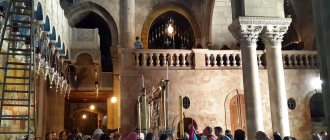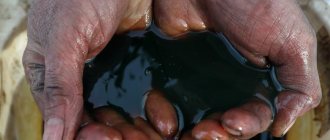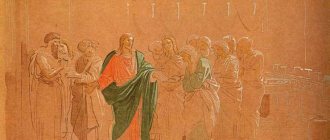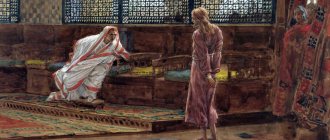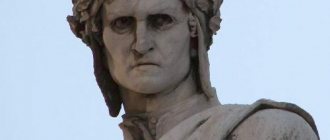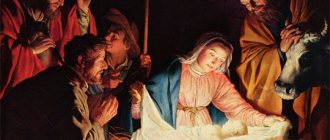Station 2: Jesus is given the cross
This is where the Church of Condemnation now stands. At this point, Pilate brought Jesus out to the crowd, proclaiming “Behold a man.” And here a cross was laid on him, which he carried to Calvary.
Tolkalina's daughter has changed greatly. How Maria ate to lose 30 kg
Photo gallery of Soviet actors who brilliantly played generals in films
“I’m not afraid to burn in hell”: Ivlev’s wife responded to criticism of the age difference
Station 5: Meeting with Simon
Here is the church of Simon of Cyrene, the man who helped Jesus carry his cross to Calvary.
He forgave Klimova’s betrayal and now they are family friends. What does the Petrenko family look like?
In Antarctica, the snow changed color and turned into green and crimson
“Blue” weather: Russians warned of a cold anomaly in the next five days
Information
- Hebrew : דרך הייסורים) – ויה דולורוזה)
- Address : starts in the Muslim quarter near the Gate of St. Stephen's Gate, or Lion's Gate, in the Old City of Jerusalem
- Phone : of course not
- Website : www.biblewalks.com/Sites/ViaDolorosa.html
- Wikipedia : https://ru.wikipedia.org/wiki/%D0%92%D0%B8%D0%B0_%D0%94%D0%BE%D0%BB%D0%BE%D1%80%D0%BE %D0%B7%D0%B0
- Working hours: 7/24
- How to get there : to the Old City of Jerusalem
- Diocese : pan-Christian shrine
- In what year was it built : 1st century. AD
- Photos from Instagram:
Stations 8, 9 and 10
First photo: the place where Jesus addressed the mourning women of Jerusalem, where he said: “Daughters of Jerusalem, do not weep for me, but weep for yourselves and for your children.” Today there is the monastery of St. Harlampius.
The second photo in the collage shows the place of the third fall of Jesus under the weight of the cross and the chapel of St. Helena.
The third is station 10: Jesus is stripped of his clothes and divided among the soldiers by casting lots. The Church of the Holy Sepulcher is located here.
Holy Land. Part 22. The Savior's Way of the Cross
Map of the Old City of Jerusalem showing the Way of the Cross of Christ The Way of Sorrows or Way of the Cross, called Via Dolorosa in Latin, was defined by the Catholic Church in the 16th century. Initially, this was not the name of the street, but a ritual of the procession of pilgrims through the streets of Jerusalem. The Way of the Cross is divided into 14 stops (stations), although there were options for dividing it into 7, 12 and even 27 stops. The modern tradition of stopping the Way of the Cross developed in the 17th century under the influence of the Franciscans.
Stops of the Way of the Cross The urban development of Jerusalem, repeatedly destroyed and rebuilt, has retained only the general direction of the Way of the Cross. The daily life of a large tourist center flows on the streets: crowds of people who have come here from all over the world, bustling merchants annoyingly offering their goods. All this interferes with prayerful concentration and rudely interferes with the deep experiences of the believer; but even in the time of Christ these places looked almost the same. People busy with everyday work fussed in the same way, the crowd made noise around them, while He carried the Cross, ascending to Golgotha.
Via Dolorosa Pilgrims visiting Jerusalem follow the Way of the Cross in reverent silence, carrying in their hands olive wood crosses containing particles of the Holy Land. These crosses, attached to all the shrines of Jerusalem, are then kept with special reverence all their lives.
The first stop for Catholics is the site of the flagellation of Christ, to which the Franciscan monastery of the Flagellation is dedicated, consisting of two chapels: the Chapel of the Cross, where, according to legend, the cross was laid on Jesus, and the Chapel of the Flagellation, in the dome of which the crown of thorns is placed.
Franciscan Monastery of Flagellation. Chapel of the Cross
Chapel of the Flagellation
Chapel of the Flagellation with a crown of thorns in the dome The Orthodox begin the Way of the Cross a little further - from Pretoria, where the Prison of Christ was located. Here, on the lower levels, several more dungeons were discovered, where, apparently, Barabbas and other robbers were kept in custody. Pretoria. Prison of Christ The Prison of Christ is a small cave with a stone bench in which holes are made for the feet; the prisoner's legs were threaded through them. Next to the dungeon is a Greek Orthodox Church.
Prison of Christ with holes for the prisoner's feet
The dungeons of the Antonia fortress, in which the Praetorium was located. From Caiaphas they took Jesus to the praetorium. It was morning; and they did not enter the praetorium, so as not to be defiled, but so that [they could] eat the Passover. (John 18:28) Praetoria was the residence of the Roman governor Pontius Pilate; it was located in the Antonia fortress built by Herod the Great north of the Temple Mount. Several covered arches were thrown from the Antonia Fortress to the Temple of Jerusalem; one of them has survived, although in a rebuilt form, and is called “Esse Homo” - “Behold the Man.”
Arch “Esse Homo” - “Behold the Man” Then Jesus came out wearing a crown of thorns and a scarlet robe. And [Pilate] said to them: Behold, Man! (John 19:5)
A significant part of the Antonia fortress has been preserved under the Franciscan monastery of the Sisters of Sion. Here you can see water collection cisterns built during the Second Temple period and called the pools of Struthion; but the main thing that attracts pilgrims here is the huge stone slabs that were part of Liphostroton - the stone platform where the last trial of Christ took place. From that time on, Pilate sought to release Him. The Jews shouted: if you let Him go, you are not a friend of Caesar; Anyone who makes himself a king is an opponent of Caesar. Pilate, having heard this word, brought Jesus out and sat down at the judgment seat, in a place called Liphostroton, and in Hebrew Gavvatha. Then it was the Friday before Easter, and it was six o’clock. And [Pilate] said to the Jews: Behold, your King! But they shouted: take him, take him, crucify him! Pilate says to them: Shall I crucify your king? The high priests answered: We have no king except Caesar. Then finally he handed Him over to them to be crucified. And they took Jesus and led him away. (John 19:12-16)
It’s scary to imagine that the feet of the Savior sentenced to execution walked on these very stones. The Liphostroton slabs bear a genuine chronicle of the life that took place on them two millennia ago. The grooves for water drainage have been preserved; notch against slipping of horse hooves; dice fields scrawled by Roman soldiers. Reverent silence and prayer reign in these dungeons. Further stops on the Way of the Cross are dedicated to both the events reflected in the Gospels and those preserved in tradition. The Armenian Catholic chapel was built on the spot where, according to legend, Jesus fell for the first time under the weight of the cross (third stop). Another Armenian chapel is dedicated to the place where the Blessed Virgin Mary stood, watching with sorrow the cruel procession (fourth stop).
The meeting place with the Blessed Virgin Mary The Franciscan Chapel (fifth stop) marks the place where Simon of Cyrene was stopped coming from the field and forced to help Jesus carry the cross. (Matt. 27:32, Mark 15:21, Luke 23:26) Near the chapel, one of the stones in the wall was polished by the hands and lips of pilgrims: according to the Franciscan tradition, in this place Jesus leaned his hand on the wall. In fact, the building belongs to a much later time and the stone cannot be considered authentic.
The place where Simon of Cyrene was stopped
Via Dolorosa. The designation of the fifth station and the emblem of the Franciscan Order The sixth station is dedicated to Saint Veronica, who wiped the dirt and blood from the forehead of Jesus, while the image of His Face remained on the scarf. On the site of the house of St. Veronica, already in the 6th century there was a monastery, now there is a Greek Orthodox church.
House of Saint Veronica On the site where, according to tradition, Jesus fell for the second time, there is a small Coptic church (seventh stop). The eighth stop is marked with a round stone with the inscription “NIKA” and is dedicated to an appeal to the daughters of Jerusalem: “And a great multitude of people and women followed Him, weeping and lamenting for Him. Jesus turned to them and said: Daughters of Jerusalem! Do not weep for Me, but weep for yourself and for your children, for the days are coming in which they will say: Blessed are the barren, and the wombs that have not given birth, and the breasts that have not nursed! then they will begin to say to the mountains: fall on us! and the hills: cover us! For if they do this to a green tree, what will happen to a dry tree?” (Luke 23:27-31)
Place of address to the daughters of Jerusalem Read more »»
Holy Land. Table of contents:
Hebron. Mamre oak; Haifa and Mount Carmel; house of Joachim and Anna. Place of the Nativity of the Virgin Mary; Nazareth; Gornensky Monastery; Ein Karem. Cave of John the Baptist; Bethlehem; Field of the Shepherds; Jordan; Jericho. Mount of Temptations; Cana of Galilee; Lake of Gennesaret. Capernaum; fish of the Apostle Peter; Magdala and the Mount of Beatitudes; Mount Tabor and the Jezreel Valley; water in Jerusalem. Cisterns, fonts and baths; Bethany. Tomb of Lazarus; Upper room of the Last Supper. Gethsemane; Gethsemane. Monastery of Mary Magdalene; Way of the Cross of the Savior; threshold of the Judgment Gate; Golgotha and the Holy Sepulcher; history of the Church of the Holy Sepulcher; structure of the Church of the Holy Sepulcher; Mount of Olives - the place of the Ascension of the Lord; Jaffa, Joppa. Sermon of the Apostle Peter; Dormition of the Mother of God. Gethsemane Tomb; Lydda. Church of St. George the Victorious; Lavra of Saint Sava the Consecrated. Lavra of Theodosius the Great. Monastery of Gerasim of Jordan.
